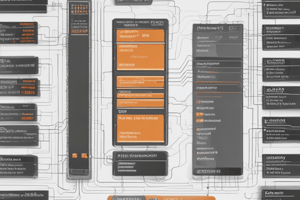Podcast
Questions and Answers
What is the primary purpose of a sequence diagram?
What is the primary purpose of a sequence diagram?
- To define the number of participating objects between two classes
- To model the interactions between actors and objects in a system (correct)
- To show the classes in a system and their associations
- To represent inheritance relationships between classes
Which of the following is NOT a key component of a class in object-oriented programming?
Which of the following is NOT a key component of a class in object-oriented programming?
- Operations
- Relationships
- Attributes
- Inheritance (correct)
In a class diagram, what do associations represent?
In a class diagram, what do associations represent?
- The inheritance hierarchy between classes
- The number of participating objects between two classes
- The composition of classes, where one class is part of another
- The links between classes that define how they interact (correct)
What is the purpose of multiplicity (cardinality) in a class diagram?
What is the purpose of multiplicity (cardinality) in a class diagram?
In the example provided, what type of relationship is described between corporate customers and personal customers?
In the example provided, what type of relationship is described between corporate customers and personal customers?
What is the difference between a composite and an aggregation relationship in a class diagram?
What is the difference between a composite and an aggregation relationship in a class diagram?
In the CompanyXYZ example, which of the following statements is true?
In the CompanyXYZ example, which of the following statements is true?
In the University System example, which of the following statements is incorrect?
In the University System example, which of the following statements is incorrect?
Which of the following diagrams is suitable for representing the flow of control in a program?
Which of the following diagrams is suitable for representing the flow of control in a program?
What is the purpose of acceptance testing?
What is the purpose of acceptance testing?
Which of the following testing techniques is used to evaluate the software's behavior under unfavorable conditions?
Which of the following testing techniques is used to evaluate the software's behavior under unfavorable conditions?
What is the purpose of sequence diagrams in software design?
What is the purpose of sequence diagrams in software design?
Flashcards are hidden until you start studying
Study Notes
Sequence Model/Diagram
- A sequence diagram is used to model the interactions between actors and objects in a system.
- It provides a clear view of the steps in a use case, showing the sequence of interactions.
- Examples of sequence diagrams include:
- Login sequence diagram
- ATM machine sequence diagram
- Sequence diagram for Dinner Now System
Class Diagram
- A class diagram is used to show the classes in a system and their associations.
- A class is defined as having:
- Attributes (member variables)
- Operations (member functions)
- Relationships with other classes
- Associations link classes together and are usually named.
- Types of associations include:
- Inheritance (e.g., CompanyXYZ has two types of customers: corporate and personal)
- Composite (e.g., something is a part of a whole but cannot survive on its own)
Class Diagram Components
- Multiplicity (cardinality) defines the number of participating objects between two classes.
- Relationships between classes include:
- Inheritance (e.g., Bank Account scenario)
- Composition (e.g., CompanyXYZ has two types of customers: corporate and personal)
Class Diagram Example
- Example: CompanyXYZ has two types of customers: corporate customers and personal customers.
- All customers can place an order, and every order is placed by a customer.
- Draw the class diagram for this scenario.
Class Diagram Example: University System
- A university consists of schools, each containing departments.
- Each department offers courses in a semester, which are taught by instructors.
- Students are enrolled in courses, which are taught in a semester.
- Build the class diagram to represent the university system.
Group Assignment
- Submit the following design models for the product (software application):
- Use case diagrams (at least 2)
- Flowchart diagram
- Sequence diagrams (at least 2)
- Class diagram
- Provide a brief description for each diagram.
Reading Assignment
- System Testing includes:
- Black box testing
- White box testing
- Unit testing
- Integration testing
- System testing
- Acceptance testing
- Stress testing
- Regression testing
Final Project
- Present the final project on March 4, 2024.
Studying That Suits You
Use AI to generate personalized quizzes and flashcards to suit your learning preferences.




